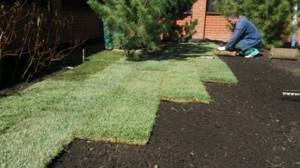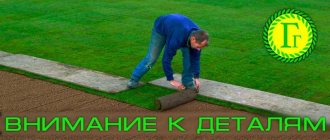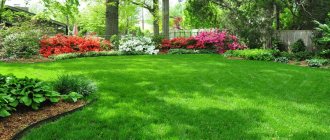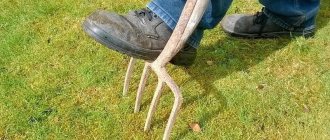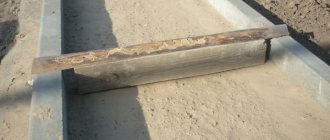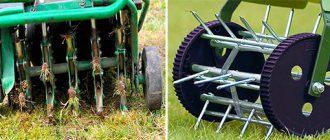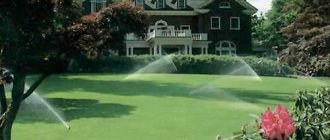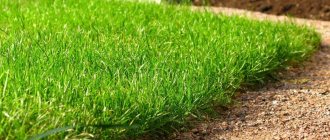A thick, bright green lawn on the site is the dream of any owner of a private house or cottage. Planting and growing a decorative grass carpet on your own is difficult. It will require systematic watering, fertilization and many other agricultural practices.
Those who do not have the time or desire to grow such grass can purchase already grown lawn in specialized stores. In order for the “green covering” to decorate the territory for many years, you should familiarize yourself with the technologies for laying rolled turf.
What is rolled lawn
Essentially, it is grass that is planted on a special basis. As the latter, burlap, cardboard or polyethylene mesh are used. The base is laid on a flat surface, this can be a dirt platform or shelving equipment. A layer of turf soil mixed with peat and sand is poured onto it. The main task is to bring the acidity of the mixture to neutral, as in nature. The thickness of the poured layer is 3-5 cm.
After preparation, grass seeds are sown. As soon as the plants rise to a height of 10 cm, they are cut off. This is done two or three times to strengthen the root system. After 2 months, the covering material is ready.
Manufacturers most often offer grass mats 2 m long, 0.4 m wide and 2-2.5 cm thick.
Rolled lawn is a multilayer material Source masterlogos.ru
Sowing lawn grass
For sowing, choose a warm but not hot day. The weather should be calm and not rainy. Seeds are sown using special seeders. These are devices that evenly distribute seeds and strictly dose them. Their use during sowing ensures the same density of seedlings. In the future, such seedlings will be able to form dense turf with a grass stand of uniform density.
After sowing the seeds, the soil is rolled with special rollers over the entire field area. This helps to embed the seeds in the soil so that birds do not peck them out or the wind blows them around. After rolling, the seeds germinate faster.
Grintek uses several seed mixtures. We select varieties of meadow bluegrass and red fescue to ensure certain properties of the rolled lawn:
- universal: four varieties of meadow bluegrass, selected so that the turf is undemanding in care, forms a beautiful and dense grass stand, and is resistant to trampling. This coating is well suited for parks, lawns, private areas, and for landscaping large areas;
- sports: varieties of meadow bluegrass that are especially resistant to trampling. We recommend using such a lawn for sports, playgrounds and children's playgrounds, as well as for areas where the grass is frequently walked on;
- shady: the base is red fescue, a shade-resistant grass with a rich, dark green tint. Forms a dense grassy cover, prefers soils with normal (not too high) moisture;
- urban: a mixture of meadow bluegrass and red fescue with high resistance to trampling, diseases, and weeds. Low-maintenance lawn grass that tolerates gas pollution and short periods of drought;
- elite: varieties of meadow bluegrass with a particularly beautiful shade of green. The lawn has a dense and uniform grass stand; thin stems of cereals form a beautiful covering. Used in decorative landscaping.
Sowing a mixture of seeds of each type is carried out in fields with the most suitable conditions. This ensures proper growth of cereals and the formation of turf with the desired properties.
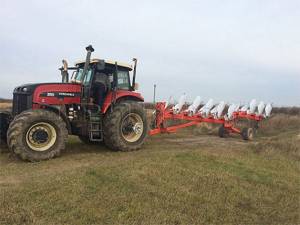
Laying technology
The technology for laying rolled lawn is divided into two main stages: preparation and laying the lawn itself.
See also: Catalog of companies that specialize in landscaping work on sites.
Preparatory stage
First of all, prepare the area itself on which it is decided to lay rolled grass. To do this, remove debris, stones, and pull out weeds. Then the drainage system is prepared. They do it like this:
- Remove the top layer of soil to a depth of 20 cm.
- is poured and leveled horizontally.
- The next layer of sand. It is leveled and compacted.
- Fill in the selected soil.
- is rolled using a metal roller.
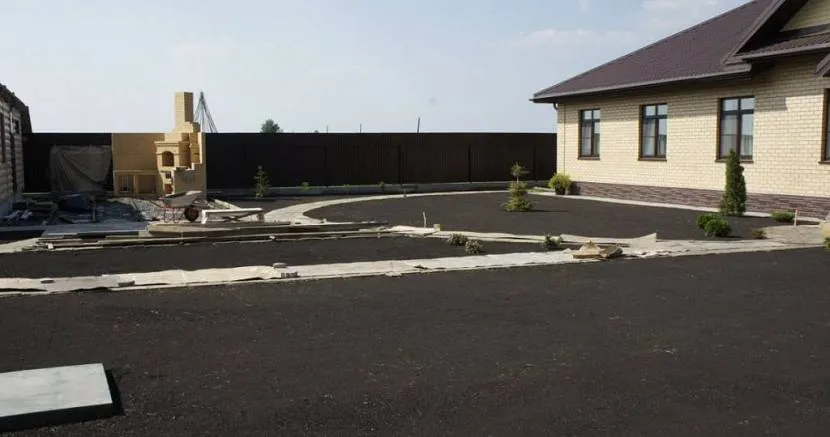
If the soil on the site is sandy, then a drainage system is not needed. It will only be necessary to clear the area and level it.
And the last process at the preparatory stage is marking. If the planted area is large enough, it is recommended to divide it into strips. That is, pegs are driven in along the edge of the site in increments equal to the width of the rolled lawn. The same is done on the opposite side. After which the pegs are connected to each other with twine.
Please note that the grass should not be higher than the garden paths after germination. And if we take into account that its height does not exceed 5 cm, then, starting from this indicator, the site is leveled.
Main stage
In principle, there is nothing complicated about this. It is necessary to lay the rolls evenly next to each other, leaving no visible gaps. It is important to lay the first roll correctly. That is, parallel to the edge of the area where the material is rolled out.
Since the rolls themselves have a certain length, often each of them does not cover the length or width of the site. Therefore, the rolls are laid in a checkerboard pattern. This is when the edge of one of them lies next to it, but before the middle of the canvas. When the entire area is covered with grass, soil mixed with sand is sprinkled between the laid strips. This way the edges of the laid roll are protected.
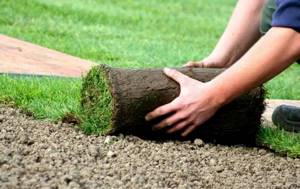
The lawn is laid in rows with a small gap Source masterlogos.ru
Rules for laying rolled grass
When the soil is ready, with peace of mind, go to the store and buy grass. It is best to plant lawns in spring or autumn, when there is enough moisture in the ground and there is no particular heat.
Let's take a look at how rolled lawn is laid:
- Start laying the rolls from the part of the site where you stacked them. This will avoid frequent transfers, during which the soil crumbles and roots are destroyed.
- We place the roll exactly on the corner of the platform and unwind it in a straight line. The first roll turns out to be the last one and it is important to lay it as evenly as possible. You cannot bend, twist, or wrap the grass. If a corner of a flower bed gets in the way of the roll, then roll along it and remove excess grass by cutting it with a knife.
- The principle of laying out adjacent rows is similar to brickwork: the rows cannot have the same joints. Those. try to ensure that the joints of the second row fall in the middle of the rolls of the first row. This will allow the grass to settle in more evenly.
- There are no overlaps in the installation of a rolled lawn. The rows should be adjacent to each other, like vinyl wallpaper - the tighter it is. Discrepancies of more than 1.5 cm are not acceptable.
- The weakest areas of a lawn in terms of survival are the edges. Try not to lay them in pieces. Use trimmings of less than a meter for the middle of the site, and lay the edges in strips of more than a meter.
- After laying out the first row, it is pressed down using a board. Be sure to run your hand over the grass to see if there are any holes or mounds underneath. If you feel unevenness, lift a piece of grass and add soil (or remove excess). After checking, tamp again.
- When the first row is laid out and rolled down, a boardwalk is placed on it, and the next rows are laid while standing on it. This will further compact the grass and prevent it from being crushed by your feet.
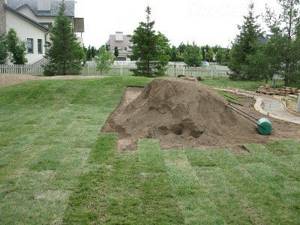
Laying a rolled lawn is similar in technology to brickwork: the joints in adjacent rows should not coincide with the joints of the previous one
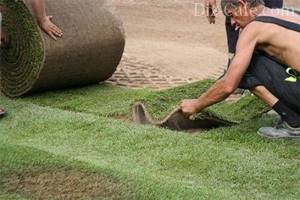
All rolls are rolled out only in a straight line, without bends or distortions. And if there is a path along the way, then the unnecessary part of the lawn is cut out with a knife
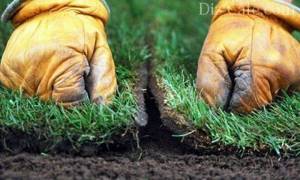
Rolls should not be laid overlapping, otherwise unevenness will form. They are laid tightly end to end, like wallpaper, with a gap of less than 1.5 cm
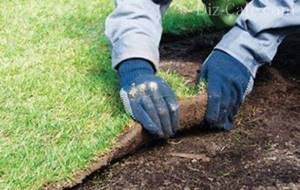
If unevenness is detected, carefully lift the edge of the lawn and add a little soil under it or, conversely, remove excess
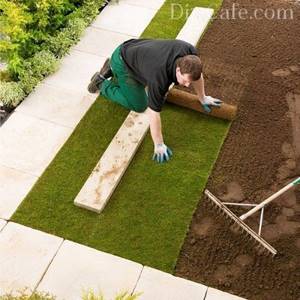
When laying the first row is completed, lay out the second one, standing on a wooden board or board, so as not to spoil the fresh grass surface with your feet.
After the lawn has been laid, it needs to be grown. To do this, the grass is watered for two weeks. Try not to allow the soil to dry out. It is best to use automatic watering with small sprinklers. Also, avoid walking on grass for a month. As a last resort, use boards or flooring to move, but remove it immediately. Fresh grass and soil are easily pressed under the weight of your feet, and your lawn may end up with dents.

Constantly watering the rolled lawn for two weeks is a prerequisite for its good survival, especially if the weather is warm.
How to care for your lawn
So, the installation of the rolled lawn has been completed, the area has been watered, what next? The main task falls on the owner of the suburban area. And it consists in not overdrying the laid material. Therefore, the grass must be watered all the time.
By the way, in order to understand whether the laid grass layer is dry or not, you need to periodically lift the edge of the outermost layer. If the layer itself is wet, then this is normal. If it’s dry, you’ll have to increase the volume or frequency of watering. The recommended dose of water for irrigation is 10-15 liters per 1 m2 of laid surface. Please note that this must be adhered to in the first two weeks after installation. After which the frequency can be reduced.
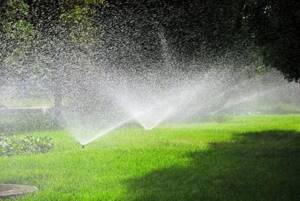
Watering laid lawn Source quora.com
Lawn care: tips and tricks
In order for the lawn to last as long as possible and delight you with its beauty, you need simple but regular care of the rolled lawn after installation.
A haircut
There is no need to cut the grass for the first 2 weeks. To begin with, it is recommended to cut off only the ends. And when the plants are fully established, the cutting height can correspond to any of your wishes.
Do not allow the cut greenery to dry out; it should be removed from the lawn immediately after trimming, as it can negatively affect the quality of the plants and cause disease and rot. Therefore, it is better to use a lawn mower with a grass catcher or a fine mulching function.
If you use a trimmer or robotic lawn mower, it is advisable to clean the lawn with a garden vacuum cleaner. An established lawn should be mowed no more than once a week.
Watering
It is recommended to water the lawn daily for the first 7 days. Irrigation time is gradually reduced. In the future, it is carried out a couple of times a week in hot weather and once in cool weather. The norm for the amount of water per 1 m² is approximately 25 liters. Too much or too little moisture can negatively affect your lawn or cause it to die.
Fertilizer application
It is best to apply granular mineral fertilizers before a rain or to water the lawn thoroughly yourself first.
When purchasing rolls, it is advisable to immediately select fertilizers; pay attention to Azofosk for the spring-summer period and Ammophos for autumn fertilization. Others made on the basis of nitrogen, potassium and phosphorus are also suitable
Aeration and scarification
The procedure is carried out 2 times a year: in spring and autumn. It consists of piercing the turf with a pitchfork to a depth of 10 cm at a short distance from each other. This is done so that air and fertilizers reach the roots, and moisture does not stagnate. The process is also necessary to clear the lawn of old fallen and dead grass and debris.
It is much more convenient to carry out aeration and scarification with devices specifically designed for this. They will not only make your work easier, but will also help you speed up the process and enjoy it.
How to choose the right one
Today there are a huge number of manufacturers who offer rolled lawns. Therefore, it is difficult for a person who does not know the intricacies of the construction of the proposed materials to choose a quality product. So here are some tips.
So, what should a lawn in rolls look like:
- With a good root system , where white roots should stand out in large quantities.
- The thickness of the turf layer along the entire length of the strip should be the same within 2-4 cm.
- The soil should not be very clayey and not very sandy. There should be no stones in it.
- The color of the grass should be rich and uniform throughout the entire surface.
- There should be no pests in both the soil layer and the grass layer.
- Complete absence of bald spots , which indicate the low quality of the proposed material.
- The grass must be mowed .

A few words about the last position. It should be noted that some unscrupulous producers try to hide some deficiencies in the vegetation in this way. For a high-quality layer, the bevel should be small so that the quality of the grass is clearly visible. The optimal grass height is 3 cm. And the mowing should be uniform over the entire area.
Buy material that was removed from the turf on the day of sale. If you are offered an old, stale product, then it will smell like rotten grass, and the tips of the cover will be yellow.
How to lay a rolled lawn with your own hands: nuances of the work
As in any other work, in the process of laying a rolled lawn with your own hands there are many insignificant, at first glance, nuances - they are such at first glance, but as practice shows, their importance cannot be underestimated. Let's consider all these nuances in more detail, and at the same time study the sequence of work related to solving the question of how to lay a rolled lawn at the dacha yourself?
Soil preparation. Most of the activities associated with this stage of work have already been described above in the corresponding section, and there is not much left to add here
In particular, talk about two points: firstly, the importance of preliminary watering of the soil, which must be done an hour before the actual laying of the lawn - without it, it is quite difficult to properly saturate the soil with the next watering after laying. Secondly, if the lawn is laid on a slope, then in order to avoid “landslides”, the soil must be reinforced with a special mesh
It would also be useful to mention here the means of weed control - professionals use such means as “Tornado” or “Roundup”.
Rolling out rolls - this must be done only in a straight line and joint to joint. If you need a tight connection, the rolls can even be trimmed. They need to be laid quickly so that the soil does not have time to dry out after watering - in the same regard, immediately before laying, it is better to moisten the lawn roll a little. The rolls must be laid in a checkerboard pattern, so that their transverse joints do not form a single line. After laying each individual piece of rolled lawn, you need to tap it with a soft rubber mallet - this moment will ensure that the turf adheres tightly to the soil. Once the entire lawn has been laid, again, in order to ensure tight contact of the turf with the soil, it needs to be rolled with a roller. This type of construction tool is not suitable here (it is too heavy and can only damage the coating) - you need a special garden roller that is light in weight. If there is none, then it is better to trample the green covering with your feet. Small gaps between lawn strips should be mulched to reduce the rate of drying of the soil under the turf.
And the final stage of work related to solving the question of how to lay a roll-up lawn at your dacha with your own hands is abundant watering, which has already been mentioned above. Both the lawn and the soil underneath should be thoroughly wet and saturated with moisture.
To conclude the topic, a few words about caring for the green surface after planting. During the first week, during the intensive establishment of the turf, the laid lawn must be watered daily and this must be done abundantly. After this period of time, when the grass has somewhat taken root, you can move on to a normal watering schedule - depending on the weather outside, the lawn is watered at intervals of one or two days. The best time to water any cultivated plants is early morning or late evening (before or after the heat). During the irrigation process, you need to ensure that water covers the entire area of the lawn - if areas deprived of water remain, then after a few days they will begin to turn yellow and dry out
This point is especially important in the first week after planting the rolled lawn.
Also an integral stage of the work on caring for a green meadow is mowing the lawn. It is recommended to make the first mowing of a new lawn no earlier than one and a half to two weeks after its installation. Plant shoots should not be shortened by more than 30% of their length - the normal grass height is 40-60mm. And a month after laying the rolled lawn, it is recommended to apply complex fertilizer for its lush growth. The best option is azofosk, the optimal concentration of which should be 20 g per 1 square meter of lawn.
Basically, that's all. As you can see, laying a rolled lawn with your own hands is by no means a difficult or problematic task. Quite the contrary, this process is quite capable of giving a person real pleasure. The most important thing here is to follow the rules described above, and then your efforts will not be in vain!
Advantages and disadvantages
Let's start with the positive characteristics.
- There is no need to prepare the soil, sow grass and care for young greenery.
- The finished green coating easily tolerates low frosts , drought and is immune to various diseases.
- Does not allow weeds .
- Easy to care for.
- Long-term operation .
And the characteristics are negative.
- High price . Rolled lawn with installation costs on average 400-700 rubles per 1 m2. The price range depends on the planted area. The higher the last indicator, the lower the price.
- A large number of low-quality products on the modern market. You can purchase material that simply will not take root or will last one season.
- The service life is an order of magnitude lower than that of a seeded lawn.
No. 7. How many rolls should I buy?
If you know the area of the area that needs to be landscaped with lawn and the area of each individual roll, then calculating how many rolls will be needed is a task for a second grade student. From the manufacturer you need to find out the area of one roll of the selected lawn, or take the length and width parameters, and then multiply them.
The next step is to determine the area of the plot devoted to the lawn. If this territory has the shape of a regular square or rectangle, then the task is simplified as much as possible. It is necessary to determine the area of this area and divide it by the area of one unit of rolled lawn.
Example . They sell us lawn in rolls 2 m long and 40 cm wide. The area of one sample is 2 * 0.4 = 0.8 m2. We need to lay the lawn on an area with parameters of 6*5 m, i.e. area 30 m2. To cover this area, you will need 30/0.8 = 37.5 rolls, rounded up to 38. In this case, a 5% reserve is provided. It turns out that we need to order 40 rolls.
If the shape of the plot is complex , there are curves, bends and other details, then it is better to draw a plan on paper and make a diagram of laying out the lawn. You will have to literally draw out each of the rolls to clearly see how many you will need. You can do it another way. From our school geometry course we remember how to find the area of a complex figure. You need to break it down into simple shapes and find the area of each of them. This is what they do, and then they proceed according to the already familiar scheme, only in this case they add 10% of the result obtained to the reserve, since if there are bends and paths, the material consumption will be higher.
